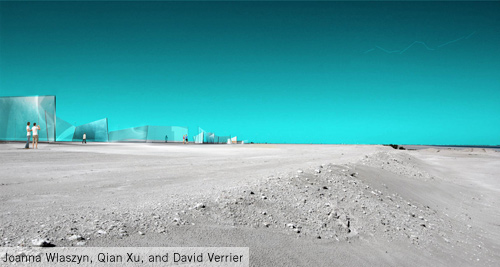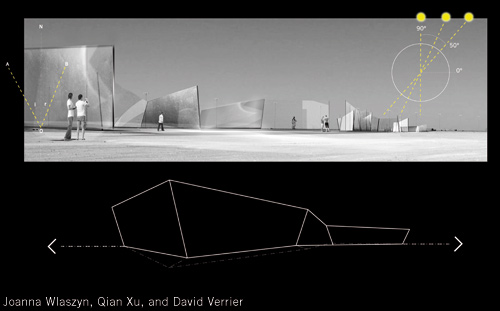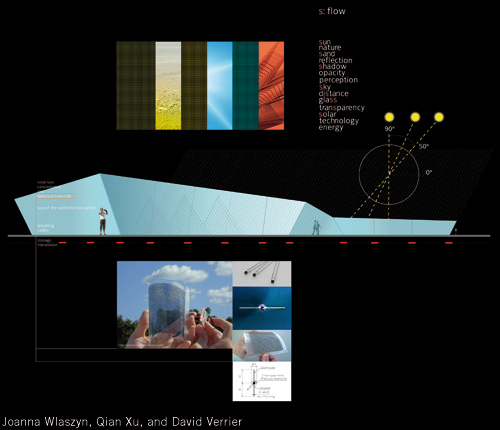Joanna Wlaszyn, Qian Xu, and David Verrier
Designed for Site #2 in Abu Dhabi, between Saadiyat Island and Yas Island.
Joanna Wlaszyn is an independent architect, designer and researcher living and working in Paris.

Design Submission for the 2010 Land Art Generator Initiative Design Competition
Artist’s descriptive text:
IDEA
The s: flow project is an active land art installation which creates a flow of visible interactions between environment, technology and phenomena of sunlight reflections. At the same time the installation questions the visual dimension of distance and length perception. s: means here: sun, sunlight, solar, sunshade, see, sky and sand. While moving along the installation, the sun reflections on the glass continuously change and create the flow of sunlight motion. Each time of the day the installation takes a whole new appearance in a permanent dialogue between light and shadow, nature and technology, and especially between man and his environment. This dialogue can be only completed by the viewers – in the way that the viewer becomes an integral part of the installation. The volume of the project is more or less visible and imposing according to the sun movement. Such a perceptual discharge of the environment is accentuated by the contrast between the blueness of the sky and the reflective sand. s: flow composes a harmony with the environment and provides a path to be followed like an invitation to the silent walk in this environment almost empty and mostly devoid of vegetation.

DESIGN CONCEPT
The shape of the installation is a simple deformation of a straight line into a spline. The spline follows the natural shape of the area’s edge: the borderline between sea and land. The form of s: flow is composed of a reflective glass which provides a vast surface for solar energy. By using material properties of glass like reflecting sunlight spectrum s: flow becomes a source of solar energy production. To keep a good transparent effect of glass, the structure of installation is made of a light supporting metal load-bearing structure as a reliable system. This construction material adopts recycle and environment protection materials. Energy captured from sunlight and its reflections on sand is transformed into electrical power by Spherical Micro Solar Cells: Sphelar. Sphelar cells optimize the use of reflected and indirect light. There is no hidden side : both sides generate electricity wherever the light source is located. Sphelar provides up to 80% high transparency possibility. Actuating cables placed in the metal structure transmit the energy to be transformed into electrical power through the grid connection cables placed in the ground. To respect the existing natural condition, the boundaries between public and restricted areas will be indicated by the invisible sound alarm system placed on the ground. The only platform to visit the installation is made by the footprints of the visitors and by the consideration of their sensibility to surroundings protection.



Related Posts
1 Comment
Add comment Cancel reply
This site uses Akismet to reduce spam. Learn how your comment data is processed.

[…] (First Place Winner) Solar (ECO) System PV Dust Solar Flock” Living Ribbon Solar Bird Artocos project s: flow Ode to the Sun Light […]